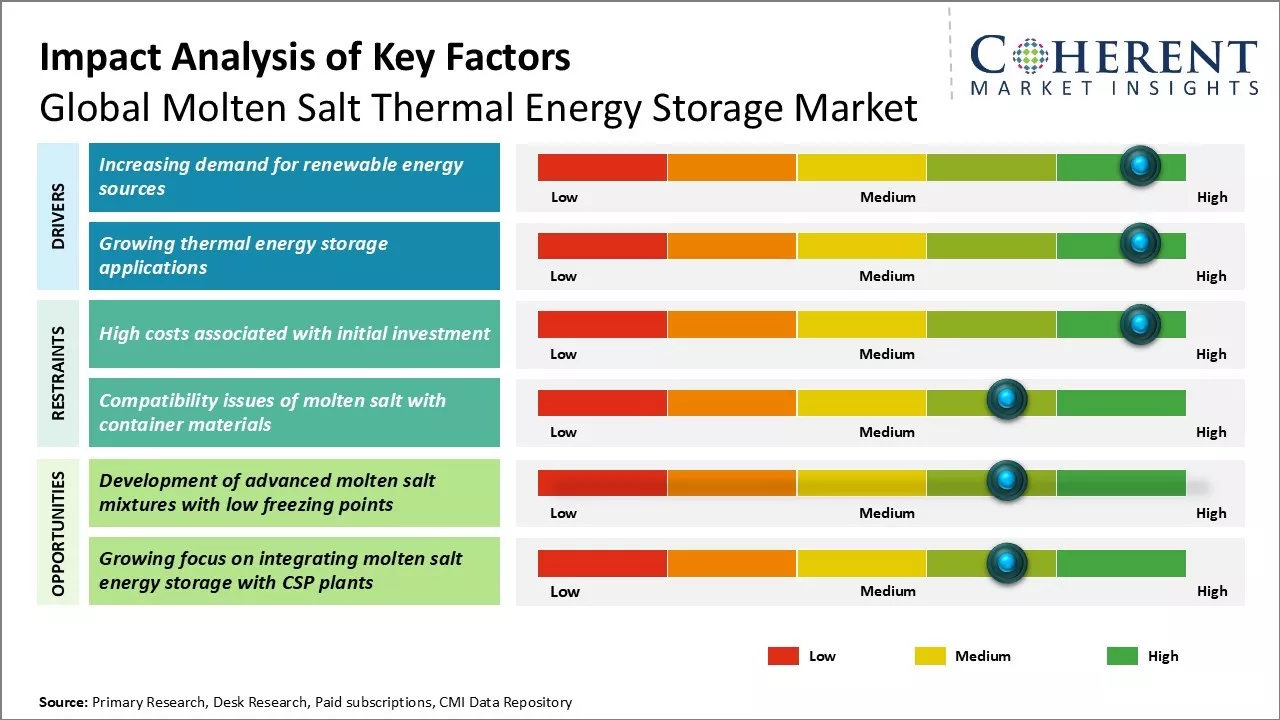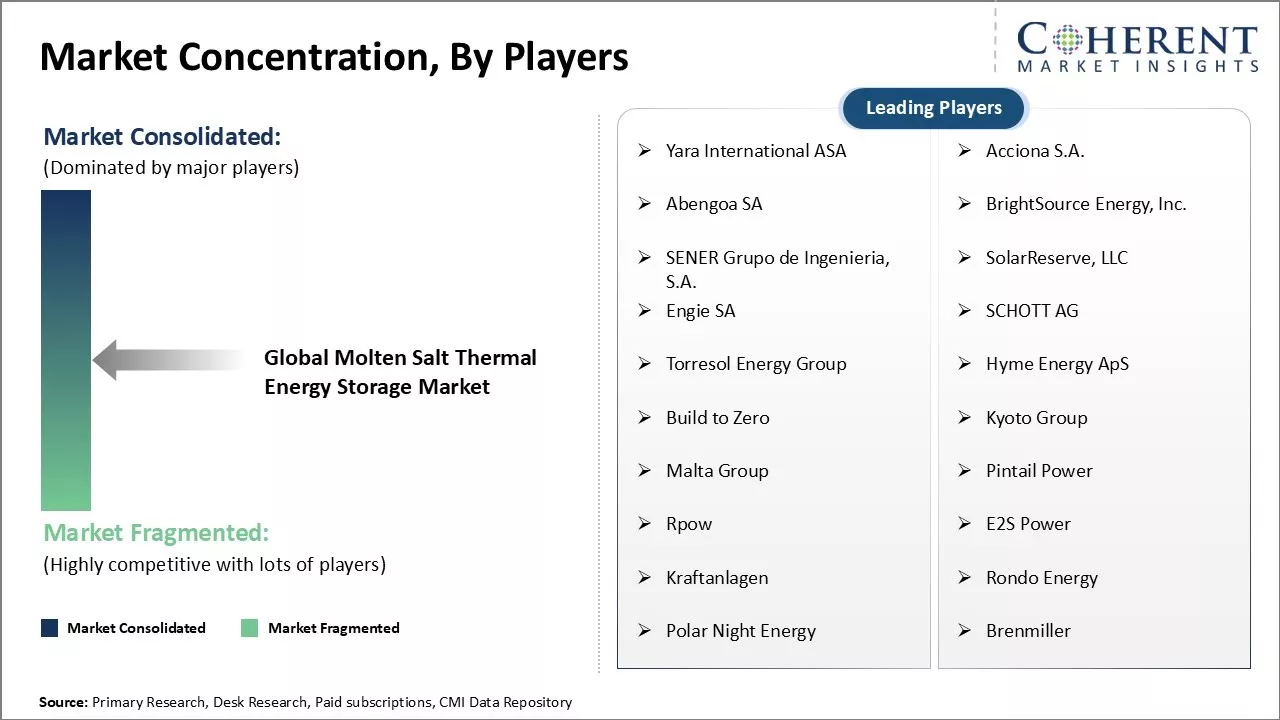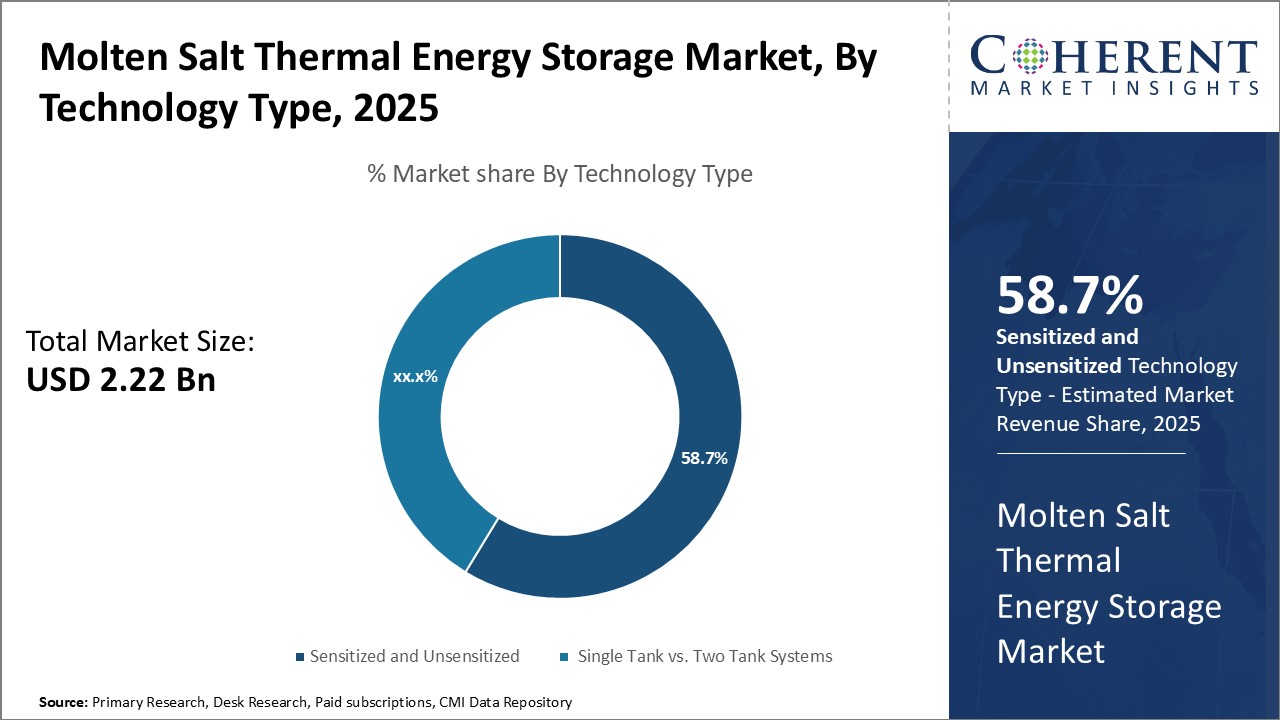Molten Salt Thermal Energy Storage Market Size and Trends
The global molten salt thermal energy storage market is estimated to be valued at USD 2.22 Bn in 2025 and is expected to reach USD 4.27 Bn by 2032, exhibiting a compound annual growth rate (CAGR) of 9.8% from 2025 to 2032.

Discover market dynamics shaping the industry: Download Free Sample
Market Driver - Increasing demand for renewable energy sources
The global energy landscape is witnessing a gradual yet steady shift towards more sustainable sources of energy that have a lower environmental impact. Renewable energy solutions such as solar and wind power have seen tremendous growth in recent years due to favorable government policies and advancements in technology which have brought down costs significantly. However, intermittent nature remains one of the key challenges for the large-scale integration of these renewable resources into the existing electricity grids. Effective energy storage plays a vital role in addressing the mismatch between the energy generation and demand profile.
Molten salt thermal energy storage systems are ideally suited to overcome this intermittency issue by storing excess heat or cold produced from renewable sources for later use. The thermal energy is stored in the form of sensible heat in molten salts which can retain high temperatures even after remaining still for long durations. This minimizes heat loss and makes it highly suitable for later conversion to electricity to meet demand during off-peak supply periods from renewables. Another salient feature is the capability of molten salt to operate at very high temperatures ranging from 300 to 600 degrees Celsius. This high operating temperature allows for effective integration with solar thermal plants for electricity generation well after the sun goes down.
With governments and regulatory bodies across major economies setting ambitious targets to increase the share of renewable power sources, the need for cost-effective long duration energy storage solutions has risen tremendously. The flexibility and technical advantages of molten salt storage over alternative options have made it a preferred technology solution, especially for utility-scale solar thermal and wind power projects. Countries with very high solar irradiation like Spain, the U.A.E, India, South Africa, Saudi Arabia, and Australia have already recognized this potential to balance renewable supply using molten salt storage. Strong policy push for renewables along with declining technology costs is expected to drive significant growth in the molten salt thermal energy storage market in the coming years.
Market Concentration and Competitive Landscape

Get actionable strategies to beat competition: Download Free Sample
Growing thermal energy storage applications
While integrating renewable energy on the grid was the initial driving mission, molten salt thermal storage is now finding wider applications beyond that in other areas. With continual improvements being made to enhance cycle efficiency and reduce costs, the usage has expanded into diverse domains like process heating for industrial operations, space heating/cooling for buildings, and waste heat recovery from manufacturing and other industrial processes. Stored thermal energy can be utilized on-demand to meet process heating needs of various industries like food & beverages, chemicals, mining, etc. without reliance on fossil fuel boilers.
Some major process heating applications that benefit significantly are desalination plants, dairy product pasteurization, textile dying, rubber, and plastics manufacturing. By using molten salt to store excess heat or cold generated from their own operations, these industries can store energy when demand is low for use in off-peak hours, thereby optimizing energy consumption. Advancements are also being made to explore Molten Salt Thermal Energy Storage (TES) potential for district heating/cooling applications where a centralized storage system provides thermal demands for multiple buildings.
Additionally, there is increasing focus on research using molten salt storage to efficiently recover and utilize low grade waste heat from diverse industrial processes that currently goes unharnessed. Countries with stringent carbon emission norms are actively supporting such innovative applications of thermal storage to further decarbonize their industrial manufacturing activities. Rising energy costs along with the need to operate processes without disruption while balancing electric grid demands have also propelled market adoption. As commercialization takes off across various niche application areas, overall growth momentum of the molten salt thermal energy storage market is likely to strengthen in the coming years on a global scale.
Key Takeaways from Analyst:
The global molten salt thermal energy storage market is poised to grow significantly in the coming years. The rising demand for renewable and clean energy sources across the globe is a major growth driver for this market. Molten salt technology provides efficient storage of thermal energy from solar and other renewable sources and releases it on-demand, which complements the intermittent nature of these sources. Adoption of molten salt storage technology allows the greater utilization of renewable sources for power generation throughout the day.
Stringent regulations curbing carbon emissions is another key factor accentuating the growth prospects of this market. Molten salt storage helps reduce the carbon footprint of power plants by enabling higher reliance on clean energy. High initial costs remain a major restraint, especially for small capacity projects. However, the technology offers good energy density and lifespan compared to other thermal energy storage methods, offsetting the higher costs over the long term.
The Asia Pacific region, led by China, is expected to dominate the global molten salt storage market in the coming years. This can be attributed to the rapid capacity additions of concentrated solar power plants utilizing molten salt technology in China. Rapid industrialization and urbanization have also driven the need for reliable and clean energy supply in the region.
Market Challenge - High costs associated with initial investment
One of the major challenges hindering the growth of the global molten salt thermal energy storage market is the high costs associated with the initial investment required for setting up a molten salt thermal energy storage system. These systems involve extensive infrastructure for the storage tanks, piping networks, heat exchangers, and other auxiliary equipment. The high energy density achieved through molten salt storage also necessitates robust and corrosion resistant materials like Hastelloy alloys which further escalates costs. Additionally, maintenance and operational costs over the lifetime of the project also remain significant. The specialized nature of technology and components also limits mass production capabilities further driving up costs. Financing such large capital outlays remains a major hurdle especially for developing countries and niche applications with uncertain return on investment timelines.
Market Opportunity - Development of advanced molten salt mixtures with low freezing points for market
One of the key opportunities for the global molten salt thermal energy storage market is the development of advanced molten salt mixtures that have lower freezing points compared to the state-of-the-art nitrate salt combinations currently used dominantly. Such mixtures that remain liquid at sub-zero temperatures can significantly expand the applications of molten salt storage to include seasonal storage schemes, concentrating solar power plants in cold climates and other industrial process heating needs where winter operation is essential. Ongoing research efforts are experimenting with salt formulations incorporating additives like lithium, potassium, and magnesium to develop eutectic mixtures with freezing points well below zero degree Celsius. Successful commercialization of such advanced salt mixtures can unlock new revenue streams and drive faster adoption of molten salt technology across diverse geographic regions and applications. Wide availability of low freeze point salts will also encourage second life applications of retired salts from CSP plants.

Discover high revenue pocket segments and roadmap to it: Download Free Sample
Insights by Technology Type: Reliability and Cost-effectiveness Drive the Demand for Sensitized and Unsensitized Storage
Within the technology type segment of the global molten salt thermal energy storage market the sensitized and unsensitized segment. is expected to account for 58.7% of the market share in 2025, due to their inherent reliability and cost benefits. Salt mixtures utilized in these systems have high melting points, allowing heat to be stored at temperatures as high as 565°C without requiring additions like metal particles. This stability enables more consistent and predictable thermal cycling than alternative technologies.
Furthermore, "pure salt" configurations avoid extra production costs and engineering complexity associated with additives. The simplicity of sensitized and unsensitized molten salt leads to lower capital expenses. Maintenance is also less frequent since contaminants and impurities that can cause degradation over time are not introduced. The reduced technological complexity combined with lower costs per unit of energy stored make sensitized and unsensitized ideally suited to meet the large-scale needs of concentrating solar power.
Insights by Application: Concentrated Solar Power Dominates Due to the Ability to Store Heat for Extended Durations
Within the application segment of the molten salt thermal energy storage market, the Concentrated Solar Power (CSP) plants segment is expected to account for 34.8% of the market share in 2025. A key advantage of molten salt technology is its ability to retain high temperature heat for extended periods, even after sunlight is no longer directly available. This allows CSP facilities equipped with thermal energy storage to generate electricity around the clock regardless of weather conditions or time of day.
The multi-hour storage capacity is invaluable for balancing the variable nature of solar irradiance and satisfying the baseload power requirements of the electric grid. It eliminates the need for natural gas "backup" to ensure uninterrupted power supplies. With fossil fuel independence and the potential for true 24/7 carbon-free solar, molten salt storage is rapidly becoming a standard feature of new CSP projects worldwide. Residential and industrial heat applications while growing, lack the around-the-clock energy needs of utility-scale solar power generation.
Regional Insights

Need a Different Region or Segment? Download Free Sample
North America has dominated the molten salt thermal energy storage market for a long time. The region is expected to hold 39.2% of the market share in 2025. The presence of major established players in countries like the U.S. has given the region an edge. Companies have undertaken substantial research and development which has allowed them to commercially deploy projects ahead of other regions. This has contributed to North America’s dominance as utilities and large industrial players look for innovative storage solutions to balance the grid with higher integration of renewable energy sources. The favorable policy environment promoting renewable energy adoption along with incentives for research have favored scaling up of molten salt technology in the region over others.
The Asia Pacific region has emerged as the fastest growing market for molten salt storage globally in recent years. Rapid industrialization and rising energy demand from countries like China and India have increased the focus on developing alternative energy sources to meet the needs of a growing population. Given the presence of huge solar and wind potential, these nations are exploring large scale energy storage as a key enabler to leverage renewables for baseload power requirements. This makes molten salt storage an attractive technology choice. Additionally, low cost of manufacturing and regional availability of raw materials provides a competitive edge for system integrators and suppliers in Asia Pacific to tap new project opportunities. The growing exports particularly to Middle Eastern and European markets also reinforce the region’s prominence as a strategic market for long term growth in the molten salt thermal energy storage domain.
Market Report Scope
Molten Salt Thermal Energy Storage Market Report Coverage
| Report Coverage | Details | ||
|---|---|---|---|
| Base Year: | 2024 | Market Size in 2025: | USD 2.22 Bn |
| Historical Data for: | 2020 To 2024 | Forecast Period: | 2025 To 2032 |
| Forecast Period 2025 to 2032 CAGR: | 9.8% | 2032 Value Projection: | USD 4.27 Bn |
| Geographies covered: |
|
||
| Segments covered: |
|
||
| Companies covered: |
Yara International ASA, Acciona S.A., Abengoa SA, BrightSource Energy, Inc., SENER Grupo de Ingenieria, S.A., SolarReserve, LLC, Engie SA, SCHOTT AG, Torresol Energy Group, Hyme Energy ApS, Build to Zero, Kyoto Group, Malta Group, Pintail Power, Rpow, E2S Power, Kraftanlagen, Rondo Energy, Polar Night Energy, and Brenmiller |
||
| Growth Drivers: |
|
||
| Restraints & Challenges: |
|
||
Uncover macros and micros vetted on 75+ parameters: Get instant access to report
Molten Salt Thermal Energy Storage Industry News
- In April 2024, Hyme Energy, a Danish energy company, made history by inaugurating the world's first molten hydroxide salt energy storage project in Denmark. This groundbreaking initiative represents a significant advancement in the field of energy storage and a crucial step towards a more sustainable energy future.
- In June 2024, an energy company made headlines by launching the world’s first energy storage facility that utilizes molten salt technology. This innovative approach to energy storage is poised to revolutionize the way we harness and utilize renewable energy, paving the way for a more sustainable future.
- In 2023, Herlogas, a leading provider of molten salt technology, collaborated with Shanghai Electric to achieve a remarkable milestone in the development of the world's largest concentrated solar power (CSP) plant, DEWA's 700 MW CSP project NOOR I at the Mohammed bin Rashid Solar Park in Dubai, U.A.E.
*Definition: The global molten salt thermal energy storage market consists of companies that develop and sell technologies to store thermal energy in molten salt for use in concentrated solar power plants. Molten salt thermal energy storage systems allow solar power plants to generate electricity even when the sun is not shining by storing heat collected during the day in large insulated tanks of molten salt.
Market Segmentation
- By Technology Type Insights (Revenue, USD Bn, 2020 - 2032)
-
- Sensitized and Unsensitized
- Sensitized (with additives)
- Unsensitized (pure salt)
- Single Tank vs. Two Tank Systems
- Single Tank Systems
- Two Tank Systems
- By Application Insights (Revenue, USD Bn, 2020 - 2032)
-
- Concentrated Solar Power (CSP) Plants
- Industrial Heating
- Residential Heating
- Others (e.g., district heating)
- By Regional Insights (Revenue, USD Bn, 2020 - 2032)
- North America
- U.S.
- Canada
- Latin America
- Brazil
- Argentina
- Mexico
- Rest of Latin America
- Europe
- Germany
- U.K.
- Spain
- France
- Italy
- Russia
- Rest of Europe
- Asia Pacific
- China
- India
- Japan
- Australia
- South Korea
- ASEAN
- Rest of Asia Pacific
- Middle East
- GCC Countries
- Israel
- Rest of Middle East
- Africa
- South Africa
- North Africa
- Central Africa
- North America
- Key Players Insights
-
- Yara International ASA
- Acciona S.A.
- Abengoa SA
- BrightSource Energy, Inc.
- SENER Grupo de Ingenieria, S.A.
- SolarReserve, LLC
- Engie SA
- SCHOTT AG
- Torresol Energy Group
- Hyme Energy ApS
- Build to Zero
- Kyoto Group
- Malta Group
- Pintail Power
- Rpow
- E2S Power
- Kraftanlagen
- Rondo Energy
- Polar Night Energy
- Brenmiller
Share
Share
About Author
Yash Doshi is a Senior Management Consultant. He has 12+ years of experience in conducting research and handling consulting projects across verticals in APAC, EMEA, and the Americas.
He brings strong acumen in helping chemical companies navigate complex challenges and identify growth opportunities. He has deep expertise across the chemicals value chain, including commodity, specialty and fine chemicals, plastics and polymers, and petrochemicals. Yash is a sought-after speaker at industry conferences and contributes to various publications on topics related commodity, specialty and fine chemicals, plastics and polymers, and petrochemicals.
Missing comfort of reading report in your local language? Find your preferred language :
Transform your Strategy with Exclusive Trending Reports :
Frequently Asked Questions
EXISTING CLIENTELE
Joining thousands of companies around the world committed to making the Excellent Business Solutions.
View All Our Clients
